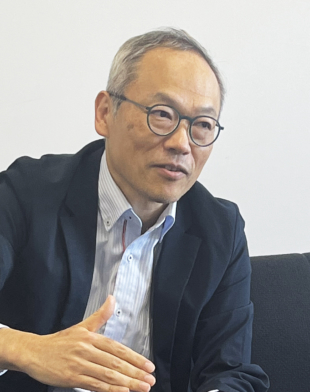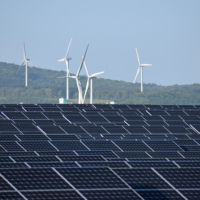Is Japan on the right track toward decarbonization? What are the obstacles to accelerating its efforts? In a recent interview with The Japan Times, University of Tokyo Vice President and economics professor Hiroshi Ohashi offered his views on these questions.

He started by acknowledging the prevailing view that energy demand will increase due to factors like the rise of generative AI, data center construction and industrial electrification aimed at reducing carbon emissions. However, he pointed out that demand has not been increasing in recent years — a trend that may continue as mitigating factors such as population decline and energy-efficiency advancements take effect.
On the other hand, various decarbonization efforts have been underway, including the installation of solar power facilities. Japan boasts the highest solar power capacity per square kilometer among major countries, and twice as much as Germany in terms of flat land.
The first Global Stocktake at the 28th Conference of the Parties to the United Nations Framework Convention on Climate Change (COP28) in Dubai, in 2023 reviewed progress made toward achieving the goals of the Paris Agreement. Japan revealed that its carbon emissions reduction efforts were on track to achieve its 2050 carbon neutrality target, demonstrating relatively better progress than many other countries.
However, Ohashi cautioned there were some underlying concerns regarding the trajectories for energy demand and decarbonization. One thing he pointed out was that industrial activities in Japan are declining as companies move their manufacturing bases to countries with looser regulations, ducking the pressure to reduce emissions.
“Will this truly lead to the desired carbon neutrality?” he asked.
He also highlighted the need to further promote investments in decarbonization technology.
Ohashi thinks that a clear road map for future growth and return on investment is a prerequisite for scaling up investments and enhancing price competitiveness to accelerate industrial green transformation.
That is why it is important to create a market for decarbonization, he said.
“Traditionally, capitalist economies are driven by market demand. However, in the context of green transformation, a new market for decarbonization needs to be created, which requires government policy to play a crucial role,” Ohashi argued.
The government liberalized Japan’s retail electricity market in 2016, leading to greater price fluctuations.
“In this context, it makes sense to adjust demand based on supply,” Ohashi said, emphasizing that introducing a carbon tax would further incentivize these kinds of adjustments.
He also mentioned the use of electricity aggregators as a key strategy.
“For example, Energy Pool Japan is an electricity aggregator based in Tokyo. These aggregators have access to operational data from their clients’ factories. By analyzing this data and considering real-time fluctuations in electricity supply and demand, these aggregators can optimize electricity consumption. This may involve adjusting the operational schedules of factories to align with periods of lower demand,” Ohashi said.
Although this method has not yet been fully applied to domestic electricity use, Ohashi argued that there is considerable potential for using this technique to cut household energy consumption. Coupling household-focused aggregation services with automation technologies can encourage increases in demand during periods of abundant supply, such as the daytime, when solar generation is high. The widespread adoption of home storage batteries and heat pumps can make using solar power even more efficient.
Ohashi also said it was important to maintain residential solar panels to make the most of their potential.
The feed-in tariff scheme (and a precursor launched three years earlier) was introduced in 2012 to encourage household adoption of solar panels by giving owners the right to sell any power generated to their utilities at fixed prices higher than the market rate for 10 years. This was made possible by the government passing on the cost of buying that power to consumers.
Given that the initial solar contracts began expiring several years ago and that purchase rates have reportedly dropped to less than a fifth of the initial rate, many homeowners have lost the incentive to continue selling and are using the excess themselves.
Ohashi emphasized that aggregators can help make use of surplus electricity generated by homeowners. “While each output may be modest, the aggregated volume has the potential to meet at least a portion of the local electricity demand,” he said.
He suggested that the maintenance of residential solar systems be carried out by local infrastructure companies. “These operators are firmly established within local communities. They will be able to play multiple roles in the electricity sector that requires stability and trust from local businesses and communities,” he said.
To bring costs down, Japanese companies can try making solar cells from domestically sourced materials, Ohashi said.
“Efforts have been made to replace imported silicon, which is conventionally used for producing solar cells, with domestically produced perovskite,” he said. Iodine is the primary material for producing perovskite cells, and Japan is the world’s second-largest producer of iodine. Ohashi said companies like Sekisui Chemical and Kaneka have been actively pursuing this possibility because perovskite cells are light, thin and flexible, allowing them to be installed on a broader range of surfaces.
However, Ohashi noted that Japan faces another big hurdle in promoting the installation of solar panels: the high installation cost.
“While we have observed a significant decrease in the prices of these devices, the installation costs remain double the global standard. This is a challenge shared with other types of power generation facilities, such as wind and offshore wind power plants,” he said.This is partly due to the labor shortage in the construction industry. Ohashi said that addressing this impediment should remain a top priority.
From a medium-term perspective, Ohashi said it will be important to decarbonize existing power plants in the near future.
“Increasing criticism toward coal power generation has resulted in the closure of some of the older thermal power plants, but losing them altogether will cause a power supply crisis,” Ohashi said.
“There are various approaches that power plants can take to achieve decarbonization. For instance, coal power plants can transition to ammonia. Liquefied natural gas-fired power plants can be modified to combine hydrogen with natural gas, gradually increasing the hydrogen content until it fully replaces natural gas,” he said.
Despite the challenges associated with hydrogen, including the cost and logistical constraints, its use is gradually expanding. Ohashi noted that the Tokyo Metropolitan Government is using fuel cell buses and signed an agreement with Yamanashi Prefecture in 2022 to promote its “green hydrogen” produced with renewable energy. The capital is also collaborating with H2 Global Foundation on a plan to establish a hydrogen trading market. In the meantime, Yamanashi and beverage company Suntory are collaborating to install a system at Suntory’s Hakushu whisky facilities in Yamanashi to produce green hydrogen.
He also touched on several private-sector initiatives to promote the gas, including a hydrogen-powered coffee roaster used by UCC Ueshima Coffee, JR East’s Hybari hydrogen train, Japan’s first hydrogen pipeline to homes and businesses in Tokyo’s Harumi district, Japan Post’s fuel cell trucks and Iwatani Corp.’s development of hydrogen production and related technologies.
There is also a method for reducing carbon dioxide emissions by capturing and storing them underground known as carbon capture and storage. A plan is underway to initiate CCS in seven locations in Japan by 2030.
Ohashi emphasized the importance of learning from the past and preserving diversity in education, training and research institutions to support the future of the energy industry.
“CCS requires geological expertise, a field that weakened in Japan with the decline of the mining industry. A similar trend has been observed in the fields of oceanography and shipbuilding. We are also facing a shortage of electrical engineers and human resources in the nuclear power sector.”
Academia must anticipate future needs for specific expertise in this rapidly evolving energy landscape to reverse this trend, he added.
To mitigate the potential impacts of energy scarcity on businesses and people, Ohashi said that a balance will need to be struck between maintaining jobs and pursuing Japan’s environmental goals.
“It is necessary for Japanese manufacturers to maintain employment and focus on domestic production in compliance with Japan’s decarbonization policies, which will contribute to achieving the global carbon neutrality,” he said.





